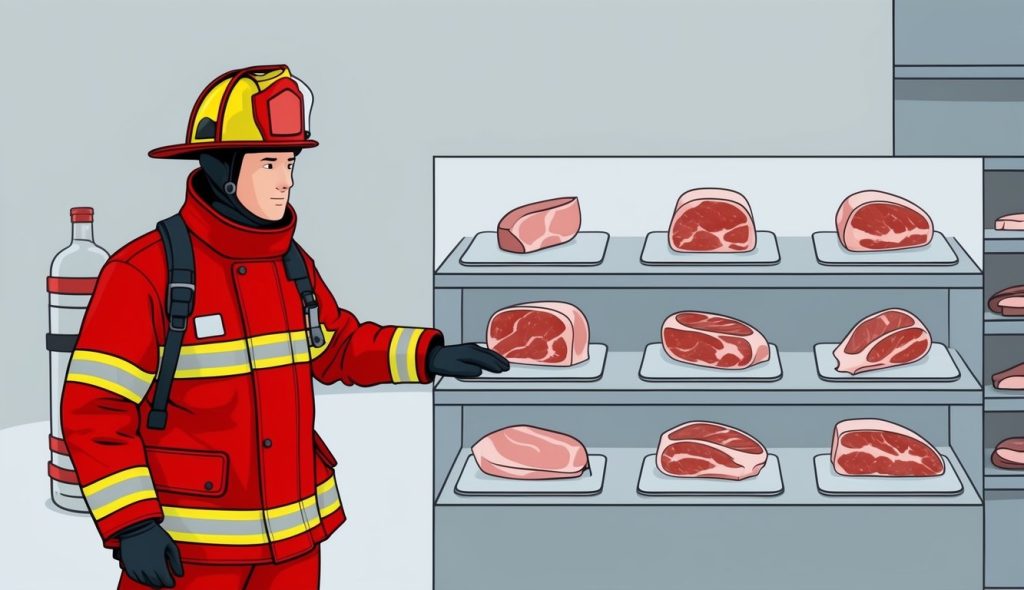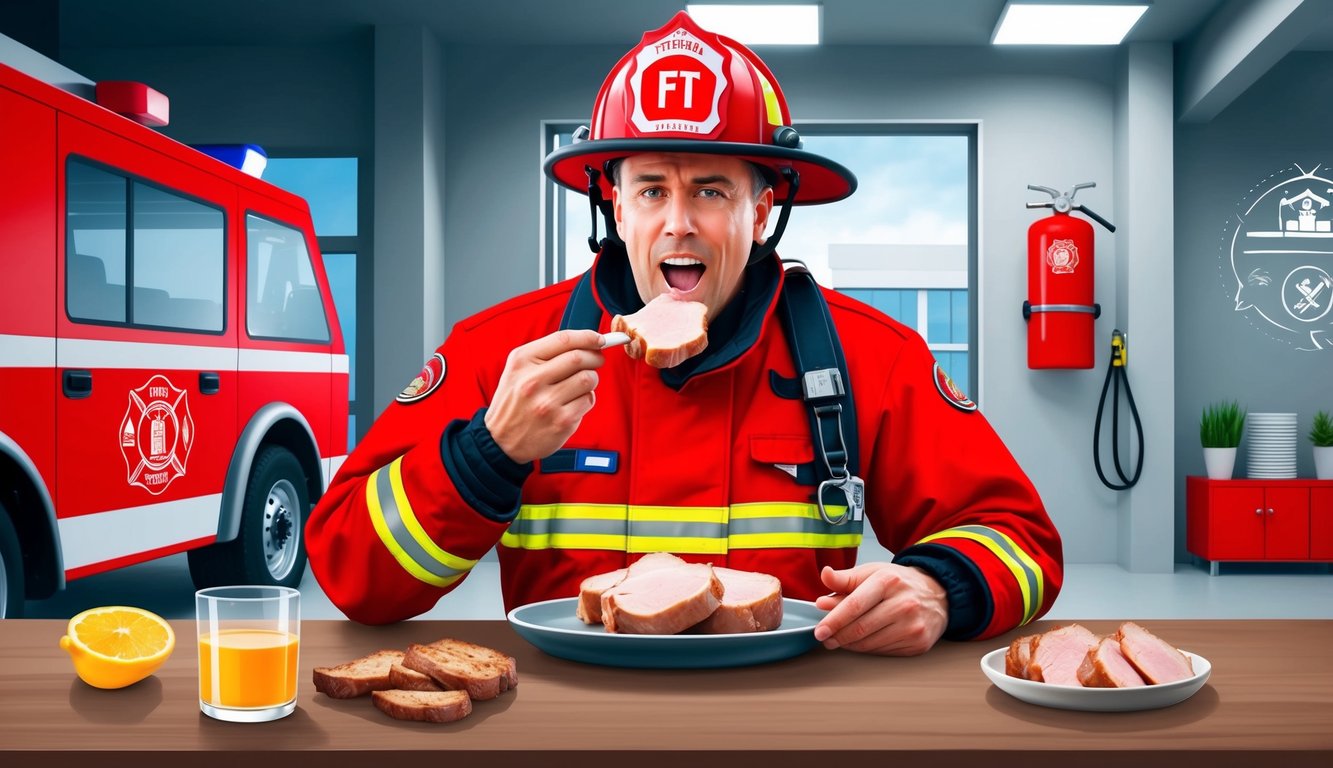The carnivore diet has gained attention as a potential nutritional approach for firefighters seeking to optimize their health and performance. This eating plan focuses exclusively on animal-based foods, emphasizing high-quality protein and fats while eliminating plant-based ingredients. For firefighters, the carnivore diet may offer benefits such as increased muscle recovery, improved energy levels, and enhanced mental clarity during demanding shifts
Firefighters require a diet that supports their physically demanding profession and helps maintain peak performance. The carnivore diet’s emphasis on nutrient-dense animal products aligns with the high protein and fat needs of these tactical athletes. By consuming a variety of meats, including grass-fed beef, poultry, and wild-caught seafood, firefighters can obtain essential nutrients to fuel their bodies and support their rigorous work schedules.
While the carnivore diet may offer potential benefits, it’s important for firefighters to consider their individual nutritional needs and consult with healthcare professionals before making significant dietary changes. Some fire departments have implemented nutrition programs that incorporate elements of the carnivore diet alongside other evidence-based approaches to support firefighter health and wellness.
Fundamentals of the Carnivore Diet

The carnivore diet centers on consuming only animal-based foods, eliminating all plant products from one’s meals. This approach emphasizes high protein and fat intake while excluding carbohydrates.
Definition and Core Principles
The carnivore diet is an all-meat diet that restricts food intake to animal products exclusively. It eliminates all plant-based foods, including fruits, vegetables, grains, and legumes.
Core principles include:
- Consuming only animal-based foods
- Focusing on high-quality protein sources
- Embracing animal fats
- Eliminating all plant foods and their derivatives
Proponents argue that this diet aligns with human evolutionary history and can lead to improved health outcomes. The diet typically includes beef, pork, poultry, fish, eggs, and some dairy products.
Comparison with Keto and Other High-Protein Diets
The carnivore diet shares similarities with ketogenic and high-protein diets but has distinct differences.
Similarities:
- Low carbohydrate intake
- High fat consumption
- Emphasis on protein
Key differences:
| Diet | Carb Intake | Plant Foods | Protein Source |
|---|---|---|---|
| Carnivore | Zero | None | Animal only |
| Keto | Very low | Limited | Mixed |
| High-Protein | Moderate | Allowed | Mixed |
The carnivore diet is more restrictive than keto or high-protein diets, eliminating all plant-based foods and focusing solely on animal products.
Carnivore Diet Food List
The carnivore diet food list is limited to animal-based products:
- Meat: Beef, pork, lamb, bison, venison
- Poultry: Chicken, turkey, duck
- Fish and seafood: Salmon, tuna, sardines, shrimp
- Eggs
- Organ meats: Liver, heart, kidney
- Animal fats: Tallow, lard
- Dairy (optional): Butter, cheese, heavy cream
Some practitioners include coffee or tea, while others exclude these beverages. Processed meats are generally discouraged due to additives and preservatives.
Health Implications

The carnivore diet may have significant impacts on firefighters’ health and job performance. This eating approach can lead to both positive and negative outcomes, affecting various aspects of physical and mental well-being.
Potential Health Benefits
Firefighters adopting a carnivore diet might experience weight loss and improved body composition. The high protein intake can support muscle growth and maintenance, potentially enhancing strength and endurance. Some individuals report increased energy levels and improved mental clarity.
The diet may reduce inflammation in the body, which could be beneficial for firefighters exposed to smoke and other inflammatory triggers. Some studies suggest that a meat-based diet might help manage certain autoimmune conditions.
Cardiovascular health is crucial for firefighters. While controversial, some proponents argue that a properly implemented carnivore diet may improve lipid profiles and reduce blood pressure in certain individuals.
Risks and Side Effects
Nutrient deficiencies are a primary concern with the carnivore diet. Firefighters may lack essential vitamins and minerals typically obtained from plant-based foods. This could impact immune function and overall health.
The high intake of saturated fat and dietary cholesterol may increase the risk of cardiovascular disease, a leading cause of on-duty fatalities among firefighters. Long-term effects on heart health require further research.
Digestive issues like constipation or diarrhea are common, especially during the initial adaptation period. The lack of fiber can alter gut microbiome composition, potentially affecting digestive health.
Dehydration risk may increase due to the diet’s diuretic effect. This is particularly concerning for firefighters who require optimal hydration for job performance and safety.
Implementing the Carnivore Diet

Transitioning to a carnivore diet requires careful planning and consideration. Firefighters can optimize their nutrition by focusing on nutrient-dense animal foods and adapting their meal preparation techniques.
Creating a Balanced Meal Plan
A well-structured carnivore meal plan centers on high-quality protein sources and healthy fats. Beef, pork, and chicken form the foundation of most meals. Organ meats like liver provide essential nutrients.
Variety is key to ensuring adequate nutrient intake. Rotate between different cuts of meat and incorporate seafood for omega-3 fatty acids. Include eggs and dairy products if tolerated.
Portion sizes should align with individual calorie needs. Firefighters may require larger portions due to their physically demanding job. Aim for 2-3 substantial meals per day, adjusting as needed.
Consider tracking macros initially to ensure sufficient protein and fat intake. A typical ratio might be 70-80% fat and 20-30% protein by calories.
Hydration and Beverages
Proper hydration is crucial for firefighters on a carnivore diet. Water should be the primary beverage, with intake adjusted based on activity level and climate.
Bone broth can be a nutritious addition, providing electrolytes and minerals. Some individuals may choose to include coffee or tea in moderation.
Avoid sugary drinks and artificial sweeteners. If dairy is tolerated, small amounts of cream in coffee can be incorporated.
Monitor urine color as an indicator of hydration status. Pale yellow indicates adequate hydration, while dark yellow suggests a need for more fluids.
Culinary Techniques and Flavor Enhancement
Mastering cooking methods is essential for long-term success on the carnivore diet. Grilling, roasting, and pan-searing are excellent techniques for enhancing meat flavors.
Experiment with different cuts to find preferred textures and tastes. Slow-cooking tougher cuts can yield tender, flavorful results.
Use butter or animal fats for cooking to increase satiety and flavor. Rendered beef tallow or pork lard can add variety to meals.
While the carnivore diet typically excludes plant-based seasonings, some practitioners allow salt and minimal spices. Experiment to find what works best for individual preferences and digestive tolerance.
Meal prep can be simplified by cooking larger batches of meat for easy reheating. This is particularly useful for firefighters with unpredictable schedules.
Dietary Considerations for Firefighters

Firefighters require a tailored nutritional approach to meet the demands of their high-intensity profession. Proper dietary choices can significantly impact their energy levels, strength, and overall performance on the job.
Energy and Strength for High-Demand Jobs
Firefighters need a diet that supports peak physical performance. Protein intake is crucial for muscle maintenance and repair. Lean meats, eggs, and fish are excellent protein sources. Carbohydrates provide quick energy for intense bursts of activity. Complex carbs like sweet potatoes and whole grains offer sustained energy.
Healthy fats from sources like avocados and nuts support hormone production and aid in nutrient absorption. Adequate hydration is essential, especially during long shifts or in high-heat environments.
A balanced meal plan should include a variety of nutrient-dense foods to support overall health and reduce the risk of chronic diseases like type 2 diabetes.
Meal Timing and Scheduling
Firefighters often work irregular hours, making consistent meal timing challenging. Eating small, frequent meals can help maintain steady energy levels throughout shifts. A protein-rich meal or snack before a call can provide sustained energy.
Intermittent fasting may be beneficial for some firefighters, potentially improving mental clarity and weight management. However, it’s crucial to ensure this approach doesn’t interfere with job performance.
Post-shift meals should focus on replenishing nutrients and supporting recovery. A combination of protein and carbohydrates can aid muscle repair and glycogen replenishment.
Carnivore Diet on a Budget
A carnivore diet, which focuses primarily on animal products, can be adapted for firefighters on a budget. Bulk purchasing of fresh meat can lead to significant savings. Cheaper cuts like organ meats are nutrient-dense and cost-effective.
Eggs are an affordable protein source rich in essential nutrients. Canned fish like sardines and mackerel offer omega-3 fatty acids at a lower cost than fresh fish.
Meal planning and preparation can help reduce food waste and control expenses. Freezing portions of meat can ensure a steady supply of protein-rich meals.
While a strict carnivore diet may not be suitable for all firefighters, incorporating more animal products can potentially support strength and endurance for their demanding profession.
Managing Cravings and Transitioning
Firefighters transitioning to a carnivore diet may experience cravings and challenges as their bodies adapt to the new dietary approach. Proper management of these cravings and careful transitioning can help ensure success on the carnivore diet.
Dealing with Cravings for Plant-Based Foods
Cravings for plant-based foods are common when starting a carnivore diet. To combat these urges, firefighters can focus on consuming fatty cuts of meat, which provide satiety and help reduce cravings. Increasing water intake and ensuring adequate salt consumption can also help manage cravings.
Identifying trigger foods and situations can be helpful. For example, if stress triggers cravings for carbohydrates, firefighters can develop alternative coping mechanisms such as deep breathing exercises or short walks.
It’s important to remember that cravings often diminish over time as the body adapts to the carnivore diet. Staying committed to the dietary guidelines and avoiding processed foods can accelerate this adaptation process.
Transitioning from Other Diets
Transitioning to a carnivore diet requires careful planning, especially for firefighters coming from other dietary approaches. A gradual transition often proves more successful than an abrupt switch.
For those transitioning from a standard diet:
- Week 1-2: Eliminate added sugars and processed foods
- Week 3-4: Reduce plant-based foods, increase meat consumption
- Week 5-6: Transition to full carnivore
Firefighters coming from a keto or low-carb diet may find the transition easier, as their bodies are already adapted to using fat for fuel. However, they may still need to adjust to the absence of plant-based foods.
During the transition, some firefighters may experience symptoms similar to “keto flu,” including headaches and fatigue. Increasing salt intake and staying hydrated can help alleviate these symptoms.
Long-Term Sustainability

The carnivore diet’s long-term viability for firefighters depends on careful consideration of health impacts and lifestyle adaptability. Proper implementation requires thoughtful meal planning and monitoring of key health markers.
Analyzing Long-Term Health Effects
Firefighters following a carnivore diet should be aware of potential cardiovascular risks. Regular health screenings are crucial to monitor cholesterol levels and heart health. Some studies suggest animal-based diets may increase inflammation, a concern for firefighters already exposed to occupational hazards.
Body composition changes warrant attention. Initial weight loss and reduced body fat are common, but long-term effects on muscle mass and bone density require further research. Nutrient deficiencies are possible without careful planning.
Blood work can help track vitamin and mineral levels. Firefighters should consult healthcare professionals to ensure their diet supports their demanding profession.
Adaptation and Customization to the Lifestyle
Sustainability of the carnivore diet for firefighters hinges on successful integration into their lifestyle. Meal prep is essential, as animal-based foods require proper storage and cooking facilities at the firehouse.
Variety within the diet is key to prevent boredom and ensure nutritional adequacy. Rotating different meat sources, organ meats, and seafood can help. Some firefighters may benefit from a modified approach, incorporating limited plant foods.
Adapting eating habits to shift work and demanding schedules is crucial. Planning high-quality, easily portable meals supports adherence during long shifts. Gradual transition for beginners can ease adaptation and minimize side effects.
Regular assessment of energy levels, recovery, and job performance helps determine if the diet is sustainable long-term for individual firefighters.
